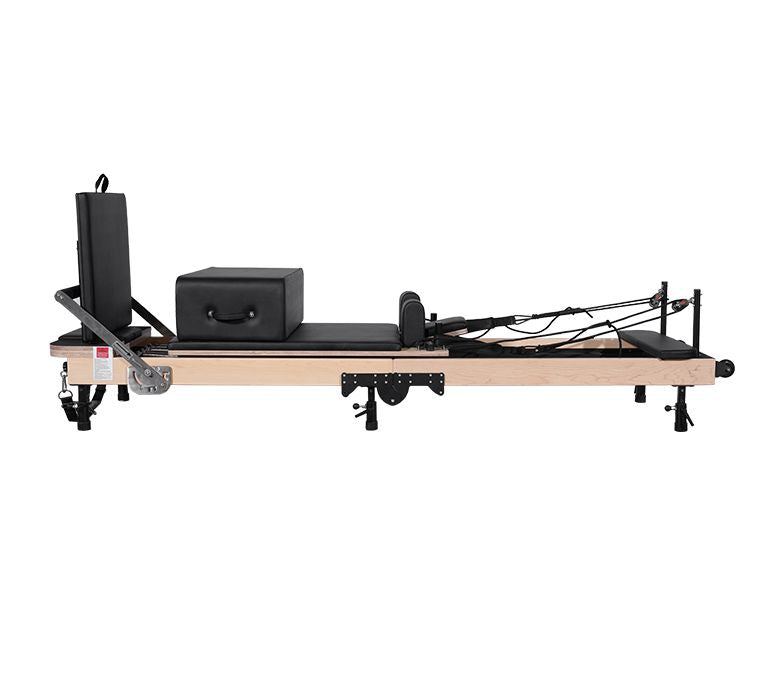The Pilates Reformer with Tower—also known as the Tower Reformer or Half Cadillac Reformer—combines the dynamic movement of a traditional Reformer with the vertical versatility of a Cadillac tower. It’s one of the most popular choices for home studios, physical therapy spaces, and boutique Pilates settings due to its space-saving design and expanded training options.
But what exactly makes up this versatile machine? Let’s break down the components and their functions so you can get the most out of your training.
Reformer Base (Horizontal System)
1. Frame
The foundation of the equipment, typically made from solid wood or aluminum alloy, is designed to provide durability and stability.
2. Carriage (Sliding Platform)
This is the padded surface that moves along the frame. It’s connected to springs and used for most horizontal exercises, especially those targeting the core, glutes, legs, and back.
3. Footbar
An adjustable bar at the front of the Reformer that allows for foot or hand placement during exercises. It helps with alignment, control, and progression across multiple movement types.
4. Spring Resistance System
The Reformer uses color-coded springs to offer varying resistance levels. These springs are connected to the carriage and allow you to customize intensity for strength, flexibility, or rehab.
5. Headrest & Shoulder Blocks
These help keep your body aligned and supported while moving on the carriage. The headrest can typically be adjusted for comfort, and the shoulder blocks provide anchoring and stability.
6. Rails & Wheel System
The smooth-gliding track under the carriage ensures quiet, stable, and low-friction movement, which is essential for controlled Pilates work.
Tower System (Vertical Resistance Unit)
Mounted at the back or head end of the Reformer, the tower system adds a new dimension of training through vertical and diagonal resistance.
7. Push-Through Bar
A metal bar that moves vertically within the tower frame, attached to springs. It’s used for exercises that target spinal mobility, shoulder opening, and upper/lower body strength.
Examples: spinal extension, bridging, overhead presses.
8. Safety Strap
Attached to the push-through bar, this strap limits the bar’s range of motion to prevent it from snapping back unexpectedly—critical for safe training.
9. Roll-Down Bar
A wooden or aluminum bar attached to lightweight springs. Used for spinal articulation, abdominal activation, and posture correction exercises.
10. Arm & Leg Springs
Springs clipped onto the tower with loops for hands or feet. These offer resistance in various planes, perfect for leg circles, arm pulls, side kicks, and more.
11. Spring Hooks / Eyelets
Multiple connection points along the tower allow users to adjust the spring height depending on the movement or the user’s height. This flexibility helps customize the workout for everyone.
Optional Add-Ons (Depending on Model)
Sitting Box – Used for seated, prone, or lateral exercises on the Reformer
Jumpboard – Adds a cardio component for plyometric footwork
Ankle Straps / Loops – Used with tower springs for leg or arm resistance work
Mat Conversion Pad – Turns the Reformer into a flat tower mat station
Summary: Two Systems, One Powerful Machine
The Pilates Reformer with Tower is the perfect blend of horizontal and vertical resistance training. It allows for a wider variety of exercises than a standard Reformer, including more spinal mobility, upper-body work, and therapeutic movement.
Each part serves a specific purpose, and when used together, they create a truly comprehensive and customizable workout system for strength, flexibility, control, and recovery.
Pro Tip: Always secure the springs and safety straps before beginning any tower-based exercise. Controlled movement and proper alignment are key to both safety and effectiveness.






Commenta
Nota che i commenti devono essere approvati prima di essere pubblicati.
Questo sito è protetto da hCaptcha e applica le Norme sulla privacy e i Termini di servizio di hCaptcha.